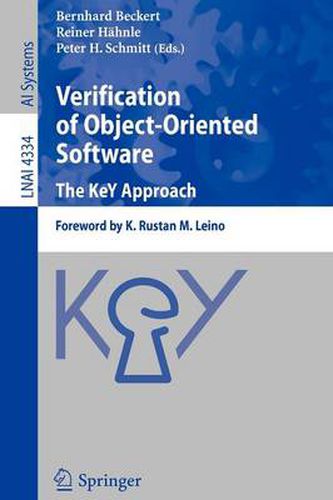Readings Newsletter
Become a Readings Member to make your shopping experience even easier.
Sign in or sign up for free!
You’re not far away from qualifying for FREE standard shipping within Australia
You’ve qualified for FREE standard shipping within Australia
The cart is loading…






This title is printed to order. This book may have been self-published. If so, we cannot guarantee the quality of the content. In the main most books will have gone through the editing process however some may not. We therefore suggest that you be aware of this before ordering this book. If in doubt check either the author or publisher’s details as we are unable to accept any returns unless they are faulty. Please contact us if you have any questions.
The ultimate goal of program verification is not the theory behind the tools or the tools themselves, but the application of the theory and tools in the software engineering process. Our society relies on the correctness of a vast and growing amount of software. Improving the software engineering process is an important, long-term goal with many steps. Two of those steps are the KeY tool and this KeY book. The material is presented on an advanced level suitable for graduate courses and, of course, active researchers with an interest in verification. The underlying verification paradigm is deductive verification in an expressive program logic. The logic used for reasoning about programs is not a minimalist version suitable for theoretical investigations, but an industrial-strength version. The first-order part is equipped with a type system for modelling of object hierarchies, with underspecification, and with various built-in theories. The program logic covers full Java Card (plus a bit more such as multi-dimensional arrays, characters, and long integers).A lot of emphasis is thereby put on specification, including two widely-used object-oriented specification languages (OCL and JML) and even an interface to natural language generation. The generation of proof obligations from specified code is discussed at length. The book is rounded off by two substantial case studies that are included and presented in detail.
$9.00 standard shipping within Australia
FREE standard shipping within Australia for orders over $100.00
Express & International shipping calculated at checkout
This title is printed to order. This book may have been self-published. If so, we cannot guarantee the quality of the content. In the main most books will have gone through the editing process however some may not. We therefore suggest that you be aware of this before ordering this book. If in doubt check either the author or publisher’s details as we are unable to accept any returns unless they are faulty. Please contact us if you have any questions.
The ultimate goal of program verification is not the theory behind the tools or the tools themselves, but the application of the theory and tools in the software engineering process. Our society relies on the correctness of a vast and growing amount of software. Improving the software engineering process is an important, long-term goal with many steps. Two of those steps are the KeY tool and this KeY book. The material is presented on an advanced level suitable for graduate courses and, of course, active researchers with an interest in verification. The underlying verification paradigm is deductive verification in an expressive program logic. The logic used for reasoning about programs is not a minimalist version suitable for theoretical investigations, but an industrial-strength version. The first-order part is equipped with a type system for modelling of object hierarchies, with underspecification, and with various built-in theories. The program logic covers full Java Card (plus a bit more such as multi-dimensional arrays, characters, and long integers).A lot of emphasis is thereby put on specification, including two widely-used object-oriented specification languages (OCL and JML) and even an interface to natural language generation. The generation of proof obligations from specified code is discussed at length. The book is rounded off by two substantial case studies that are included and presented in detail.